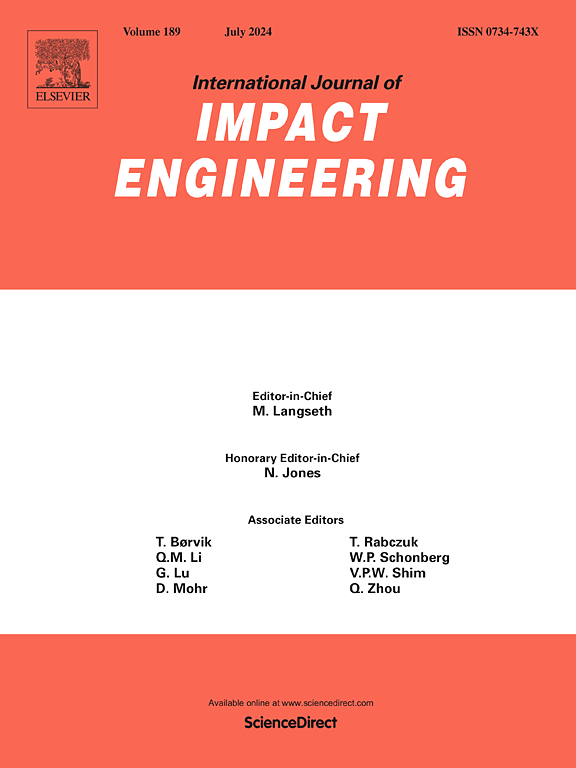提高光伏板冰雹安全性的冰球冲击特性试验研究
IF 5.1
2区 工程技术
Q1 ENGINEERING, MECHANICAL
International Journal of Impact Engineering
Pub Date : 2025-03-29
DOI:10.1016/j.ijimpeng.2025.105315
引用次数: 0
摘要
由于气候变化,冰雹越来越频繁,强度也越来越大,尤其是在高寒地区。正如 IEC 61215(25 毫米冰雹,时速 80 公里)和瑞士 VKF(最小 30 毫米或更大)等标准所概述的那样,光伏组件的抗冰雹冲击能力正在不断提高。随着冰雹大小和速度的增加,需要提高安全系数,这可以通过升级冰雹试验台来实现。首先,必须用冰球标准模拟冰雹的冲击力。在速度为 25、50、75 和 100 米/秒,温度为 -4 至 -28°C 的条件下,对直径为 25 至 90 毫米的冰球的冲击速度、冲击角度(0° 和 45°)和持续时间进行了研究。实验数据使用无量纲峰值力和相应时间作为无量纲速度和冲击角度的函数进行分析。此外,还研究了准静态和高应变率条件下的抗压强度和间接抗拉强度与温度的关系。根据这些结果,分析了定义为冰的冲击速度、样本大小、动态拉伸强度、密度和弹性波速函数的经验关系,并与文献中的研究结果进行了比较。本文章由计算机程序翻译,如有差异,请以英文原文为准。

An experimental investigation of ice ball impact behaviour to improve PV panel hailstone safety
Hailstorms are becoming more frequent and intense due to climate change, particularly in alpine regions. PV module resistance to hail impacts is being improved, as outlined by standards like IEC 61215 (25 mm hailstones at 80 km/h) and Swiss VKF (30 mm minimum or larger). Increasing hailstone size and speed, increased safety margins are needed and it can be achieved with upgraded hail test stands. Initially, the impact of hail simulated by standards with an ice ball must be examined. Impact velocity, impact angle ( and ), and duration were studied for ice balls with diameter ranging from 25 to 90 mm at speeds of 25, 50, 75 and 100 m/s and temperatures ranging from to C. Experimental data were analysed using dimensionless peak force and corresponding time as a function of dimensionless velocity and impact angle. Furthermore, compressive and indirect tensile strengths were studied in quasi-static and high strain rate regimes as a function of temperature. Based on these results, empirical relationships defined as functions of the impact velocity, sample size, dynamic tensile strength, density, and elastic wave speed of ice were analysed and compared with findings in the literature.
求助全文
通过发布文献求助,成功后即可免费获取论文全文。
去求助
来源期刊

International Journal of Impact Engineering
工程技术-工程:机械
CiteScore
8.70
自引率
13.70%
发文量
241
审稿时长
52 days
期刊介绍:
The International Journal of Impact Engineering, established in 1983 publishes original research findings related to the response of structures, components and materials subjected to impact, blast and high-rate loading. Areas relevant to the journal encompass the following general topics and those associated with them:
-Behaviour and failure of structures and materials under impact and blast loading
-Systems for protection and absorption of impact and blast loading
-Terminal ballistics
-Dynamic behaviour and failure of materials including plasticity and fracture
-Stress waves
-Structural crashworthiness
-High-rate mechanical and forming processes
-Impact, blast and high-rate loading/measurement techniques and their applications
 求助内容:
求助内容: 应助结果提醒方式:
应助结果提醒方式:


